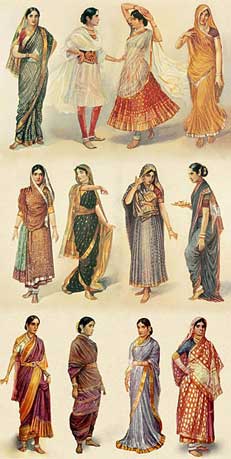 The Saree has been worn by thousands of women for centuries in India and it still remains to be an essential piece of garment in any Indian woman’s wardrobe even today. It is not only a piece of a garment but continues to be a timeless piece of art. The saree plays an important role in traditional occasions and is a regular staple of inspiration to most designers. One cannot exude more grace and style than in a well-draped saree. Through our country, there are various styles of sarees – based on the length, design, and pattern and ways to drape a saree.
The Saree has been worn by thousands of women for centuries in India and it still remains to be an essential piece of garment in any Indian woman’s wardrobe even today. It is not only a piece of a garment but continues to be a timeless piece of art. The saree plays an important role in traditional occasions and is a regular staple of inspiration to most designers. One cannot exude more grace and style than in a well-draped saree. Through our country, there are various styles of sarees – based on the length, design, and pattern and ways to drape a saree.
Some more information about the most popular types of saree draping styles:
Normal (Nivi):
The saree is draped once around the waist and pleats are formed and tucked in the middle facing left. The remaining cloth goes over the left shoulder to cover the torso. The pallu could be pinned neatly to the wearer’s shoulder or could be left open.
cloth goes over the left shoulder to cover the torso. The pallu could be pinned neatly to the wearer’s shoulder or could be left open.
Gujarati:
The pleats face right instead of left. The pallu also comes from the back to the front from the right side. The edge of the pallu is tucked at the back securing it properly.
Bengali:
The sari is wrapped around the waist (you don’t pleat the sari) and drawn back to the right side and the pallu goes over the left shoulder. Once again pulled up from under the right arm, it is slung over the left shoulder. Often a key bunch is added to the edge, to complete this drape.
Maharashtrian (Nauvari):
You require a 9-yard saree for this style. The saree resembles a dhoti style as some of the fabric tucked between the legs to divide them. It is worn without a petticoat underneath. The sari is draped in a way that the center of the sari is neatly placed at the back of the waist and the ends of the sari are tied securely in the front, and then the two ends are wrapped around the legs.
Kerala (Mundum Neriyathum):
This is a saree with two pieces – there is the bottom piece (mundu), which is worn separately, and the top portion (Neri ya Thu) to be used as pallu. This saree can be draped either in the customary style in which the neriyathu is tucked inside the blouse or the more modern style in which the neriyathu comes over the left shoulder.
